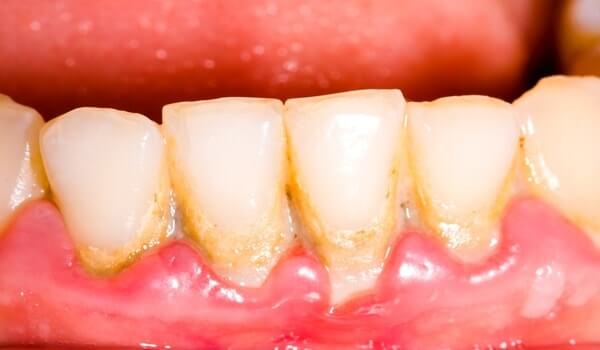Inflammation of the teeth and gums | Your comprehensive guide
Do you bleed from your mouth when brushing your teeth? So you suffer from gingivitis. But there is no reason to worry, as although the situation is serious, it can be easily resolved.
Tooth and gum disease is one of the most common and common oral diseases among people. We all have a slight or severe degree of gingivitis.
As the statistics of the US Centers for Disease Control and Prevention (CDC) acknowledge that 47% of Americans suffer from gingivitis in one form or another, and that 30% of adults around the world have had some degree of gingivitis.
Considering that the gums are a very important part of the shape and beauty of a smile, taking care of them is important, not to mention, of course, the serious complications that may result from neglecting the treatment of this inflammation, which may eventually lead to tooth loss.
But again, dear reader, do not worry, the treatment of stomatitis and gingivitis is simple, and you can easily return to normal.
What is gingivitis?
It is an early stage of gum disease, which appears as swelling and redness on the edge of the gingival tissue. This inflammation, if not treated early, develops into a more serious disease such as periodontitis or bone infection around the teeth.
But how do you know you have gingivitis? And what are the reasons? And most importantly, how can you cure it?
All this and more we will know together through the next lines.
Symptoms of inflammation of the teeth and gums
Gingivitis is usually painless and you cannot feel it. But there are some other symptoms that tell you that there is a real problem. These symptoms are:
- Gum redness:
This may be the first and mildest symptom, as the gums turn dark red or even violet.
- Bleeding gums:
It is the most common symptom, and a sure indication of a gum problem. Bleeding is often while brushing teeth or when using medical dental floss, or even in some cases the patient wakes up and feels the taste and smell of blood in his mouth.
- Swelling and swelling of the gums:
Swelling is a very important sign of inflammation in general, which is a reaction of the body to bacteria, and also a strong stimulus for you to seek appropriate medical help.

- Recession and receding of the gums:
In an advanced stage of the disease, the gums begin to retract and recede leaving part of the root exposed, causing the following symptom.
- Tooth sensitivity:
Gum recession exposes part of the tooth root, which is a sensitive part over which a covering of gum and bone should lie. When the gums and bones recede, the surface of the root gets very sensitive to anything, especially cold drinks, and the patient feels pain and sensitivity.
Do you feel confused?
And do not know how to determine whether you suffer from inflammation of the teeth and gums or not?
Here’s a quick comparison between healthy and sore gums:
| The face of comparison | healthy gums | Inflamed gums |
| gum color | light pink | Dark red, reddish blue or violet |
| texture | Solid | Soft and fluid |
| the shape | Thin | thick |
| the size | harmonic | puffy |
Causes of inflammation of the teeth and gums
The main cause of inflammation of the teeth and gums isplaque“.
Plaque consists of a thin white layer on top of the teeth, especially at the tip of the gums in contact with the surface of the tooth. It is leftover food on which bacteria gather, which in turn begin to multiply and harm the gums, causing inflammation.
This layer is formed very quickly and is renewed periodically, so brushing the teeth twice a day is the only way to remove it and prevent its formation.
If the black layer is not removed, over the days it begins to attract more bacteria, and then calcium and minerals are deposited on it from saliva and it turns into a hard layer, and it becomes what we call dental tartar.
Dental tartar also begins to attract bacteria that cause inflammation, which is the second factor in causing inflammation of the mouth and gums.
Tartar removal requires a visit to the dentist, because it is a hard layer that cannot be removed with brushing and toothpaste.
These were the direct and main causes behind the occurrence of gingivitis and teeth, but there are also factors that lead to an increase in the incidence of this inflammation.
Risk factors leading to gingivitis
- Hormonal changes that occur during puberty and pregnancy, as well as at the time of the menstrual cycle and when reaching menopause (45 years).
- Some autoimmune diseases such as AIDS and leukemia.
- Diabetes.
- Taking some medications, such as epilepsy medications and some types of heart medications, as well as contraceptive pills, increases the incidence of dental and gum infections.
- Chemotherapy for cancerous tumors.
- Malnutrition, especially vitamin C deficiency, as it is very important for the health of gum tissue.
- Dry mouth, which can be caused by high blood pressure medications.
- Not paying attention to oral and dental hygiene on a daily basis.
- getting old.
- smoking.
Complications of gum ulcers
When gingivitis is neglected and not treated, the situation develops for the worse to become “periodontitis” of ligaments and bones, so the teeth begin to move and it may end up falling and losing the teeth as a result of the erosion of the bones around them.
Some other complications:
- The appearance of an abscess in the gums
- Severe ulcers in the gums
- Inflammation of the dental nerve as a result of bacteria leaking into the roots
So, bone and periodontitis is the most important and common complication, but some research revealed a relationship between gingivitis and some other serious diseases, such as:
- Some cardiovascular diseases such as heart attacks and strokes
- Some respiratory diseases (lung diseases)
- Diabetes
Although there is a relationship between gingivitis and these diseases, this does not necessarily mean that it is the cause. Some research indicates that the bacteria that cause inflammation of the teeth and gums leak into the bloodstream and move to the heart and other organs, causing infections and diseases, but this matter needs more studies to prove it, as indicated by the American Centers for Disease Control and Prevention.
Oral and gingivitis treatment
The treatment of gingivitis is to completely remove the tartar and plaque from the surface of the teeth, as well as from under the gum line and also from the roots, through tools and devices dedicated to cleaning at the dentist.
The patient then uses a mouthwash prescribed by the doctor, and brushes his teeth daily with brush and paste, and also cleans between the teeth using medical floss.
Maintaining the patient’s dental hygiene represents 50% of the treatment, because if he neglects to brush his teeth, things will return to what they were and the gums will begin to inflame again.
How do I protect myself from infection and gum ulcers?
Prevention methods revolve around maintaining oral and dental hygiene, as well as a healthy lifestyle.
- Commitment to brushing and flossing teeth twice a day, including once before bedtime.
- Use medical dental floss to clean between the teeth, once a day (Use medical floss just before brushing your teeth).
- Use the mouthwash once a day before bed (after brushing and flossing).
- stop smoking.
- Visit the dentist periodically to remove deposited tartar (it is recommended to remove tartar deposits every 6 months).
These were the most important highlights on the topic of dental and gum inflammation, its causes and how to prevent it, and we knew together that the secret word is dental hygiene and daily brushing and toothpaste. So, keeping your teeth brushed twice a day and visiting the dentist once every 6 months protects you from gingivitis.
If you feel any of the symptoms mentioned at the top of the article, go immediately to the dentist and seek medical help, as inflammation of the teeth and gums is a matter that deserves attention and treatment, because of its serious complications and effects that may eventually lead to tooth loss.

